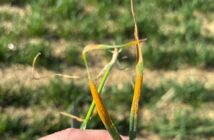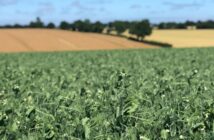Corteva Agriscience will be providing weather data by postcode on their website (https://www.corteva.co.uk/tools-and-advice/kerb-weather-data.html) and on Farming Online (www.farming.co.uk/tools/corteva), as they have done in the past, but now with greater ease of access through their popular Arable App. Designed for both Apple and Android devices and operating 24/7, users can utilise the web and app facility from 19th October. The weather data for propyzamide will form an important part of this Arable App.
According to their labels, products containing propyzamide (as in Kerb® Flo 500 and AstroKerb®) can be applied to oilseed rape from the 1st of October, providing the crop has at least three leaves. However, to make sure the residual activity of these herbicides is optimised against blackgrass and other grass weeds, soil temperatures need to have fallen below 10°C whilst soil moisture should be sufficient but not saturated. “There are a few weeks to wait. From experience and under normal circumstances, conditions for propyzamide usually become suitable for applications from around Bonfire night, 5th November”, says Tom Sowerby, technical specialist for Corteva.
Available from 19th October, Corteva Agriscience will go live with its weather data decision support system to help optimise application timings of AstroKerb (propyzamide and aminopyralid) and Kerb Flo 500 (propyzamide). “The system is meant as a guide to local weather conditions to aid growers and advisors in making local tactical decisions to optimise Kerb and AstroKerb application timings. The system is based on traffic lights with a red traffic light indicating that soil temperatures in the selected postcode area are too high and therefore unsuitable, so these herbicides should not be applied. Propyzamide will breakdown more rapidly at higher soil temperatures and blackgrass control will be compromised. If the traffic light shows amber, conditions are getting closer, so you should get ready to apply and if it goes green, conditions are broadly suitable, so you are advised to go and check individual fields. Whilst this is not a definitive instruction to apply the herbicide, it is a strong indicator for growers to look carefully at conditions for any field,” says Mr Sowerby.
The decision support system (DSS) also indicates wind, rainfall and a national soil temperature summary every ten days to help growers and advisors plan their spraying workload more effectively. These reports carry information on getting the best from propyzamide-containing herbicides, plus national maps of soil temperatures and moisture deficits are available.
Tom explains that this tool is a guide for growers and advisors to help them identify when conditions are suitable for applying propyzamide in their locality. Growers and advisors enter their postcode, and the system indicates the current status of criteria that influences the decision to make herbicide applications containing propyzamide in that area.
“Optimising ASTROKerb and Kerb’s performance, requires three areas need to be considered – soil temperature, soil moisture and weed seed depth. Soil temperatures must be cooling – around 10C and falling. At cooler temperatures, the herbicide lasts longer in the weed germination zone and so its activity is greater. The half-life of propyzamide at 10°C is around 100 days whereas at 15° the half-life falls to 60 days. Hence the need for cooler soils,” Mr Sowerby explains.
“Soil moisture is needed to distribute residual herbicides evenly in the top few centimetres, which is where the weeds germinate. Soils must not be waterlogged or saturated. Care must be taken to avoid any risk of contamination to water and importantly, all aspects of good water stewardship must be adhered to. Applications should be delayed if field drains are running, or if significant rainfall is forecast in the coming 48 hours. Also, any fields with a gradient of more than 5% down towards a watercourse must already have a grass buffer strip of at least 5 metres established if AstroKerb or Kerb Flo 500 is to be used. Where gradients are more severe, the grass buffer strip should be wider. Good stewardship of residual herbicides in rape is vitally important to ensure the long-term availability of these herbicides.”
AstroKerb and Kerb Flo 500 require the same conditions for application and have the same wide application window of four months, starting from the 1st of October through to the end of January.
“AstroKerb delivers the same weed spectrum as Kerb Flo 500, with the addition of mayweed species and common poppy. We would expect activity on sow thistle and groundsel too.”
“Weeds, particularly grassweeds such as blackgrass and ryegrass need to pick up a lethal dose of propyzamide. Both these weeds are difficult to control in cereals and many growers are growing oilseed rape as a break crop in which weed seed populations can be reduced. If Kerb and AstroKerb are given the best conditions to work they can give levels of control of over 90%, a level that is almost unprecedented with other graminicides in cereals nowadays,” he says.
In forward crops, large canopies may be closing in rows before the weather system indicates green for go. Corteva Agriscience trials over many years have shown blackgrass control from propyzamide is not impeded by large crop canopies.
–




